Photos Make Up For Your Sucky Brain
“’When I think about Instagram, I think about moments,’ said [CEO Kevin] Systrom. He’s explaining how life is short and taking pictures is the only way to preserve memories destroyed by naturally declining brain functions, but in less words.”
I Was Paid $12.50 An Hour To Write This Story
by Noah Davis
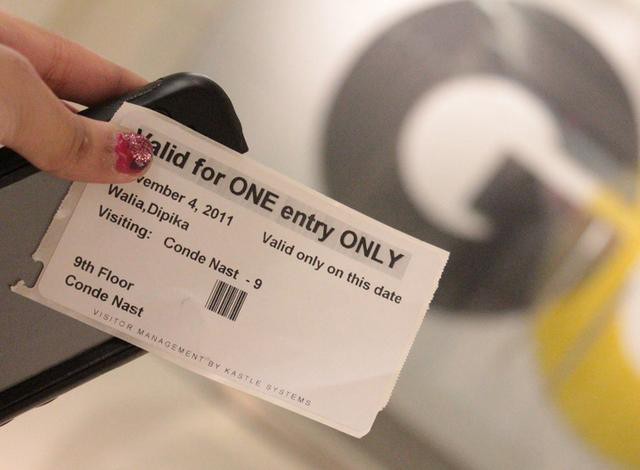
I didn’t know what I would get paid to write this article. I didn’t ask. It doesn’t matter. It won’t make a tangible dent in paying the rent on my apartment in Brooklyn, or, for that matter, rent on an apartment in any other city. By the time I finish the research, the interviews, the writing, and the editing, whatever small sum — $30, $125, $200 — this site pays me will pale in comparison to the effort. It’s not “worth it” in a traditional monetary sense. I’m doing it for exposure (maybe hire me?), because I’m interested in the topic, and because it’s immediately relevant to my so-called career as a freelance writer. With apologies to H.L. Mencken, this really isn’t about the money.

It’s not news that making a living by writing on the Internet is a tough business. Freelancing for websites is nearly unsustainable, especially in the one-off pitch, write and edit sense. But here’s the thing: It rarely makes financial sense for the website, either. This piece alone will almost certainly lose money for The Awl; nearly all the site’s pieces do. (Sorry, gang.) That’s true across the Internet, as a few big hits, the site as a whole, or big-name writers carry the rest. While Nate Thayer and the Atlantic battled over a piece the publication asked to run for free, chances are good that if the editors paid him, they would have lost money. This doesn’t make the request more or less legitimate, but it is relevant in the never-ending calculus of creating a profitable publication.
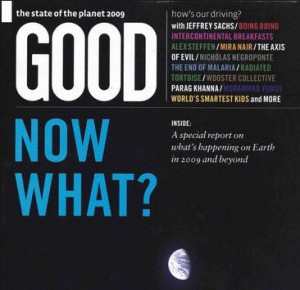
Nicholas Jackson worked as an editor at TheAtlantic.com and saw the math first-hand. He has moved on, first to Outside’s website and now to Pacific Standard (I had or have contracts with him at both outlets). At The Atlantic’s website, he had a monthly freelance budget to use at his disposal, but pieces pitched by the random freelancer rarely made a positive impact on the bottom line. “I can look at it and say that the piece wasn’t worth the $100 we paid,” he said. “These littler freelance pieces are being subsidized by the James Fallows of the world. There’s a small handful of people who can make money online. The hope is that you balance all of that out.”
Assume an editor pays a writer $100. Taking as a random decent example a $5 CPM, the piece would need 20,000 pageviews to make that $100. That doesn’t take into account the editor’s salary, the salaries of any developers, or any other costs beyond getting letters into a Word document. (In particular, the people selling the ads tend to get paid more than all the rest of those people.) In any event, a person can’t afford to do much reporting or spend too much time writing if he or she is only getting $100 a story and planning to make a living. The likelihood of that story breaking out in any meaningful way is pretty low.
There is a general correlation between good, hard work and success, but it’s not one-to-one. When Ann Friedman edited Good, the magazine produced big, ambitious work, some of which found a wider audience and some that did not. Success was unpredictable. “A lot of that really high quality work were the hits. But there were one or two that weren’t for every one that ‘hit,’” she said.
In that way, making money on the web has much in common with book publishing, just with more cat photos.

The Internet democratized writing. Obviously. Nearly anyone can string together a few sentences and try to find an audience. Writing seems like an easy gig, or at least one for which no additional knowledge base is required. There’s a reason Will Hunting’s intelligence is shown through his math prowess, not his ability to pen a paragraph. The number of “writers” exploded, even while one estimate for the number of official jobs for full-time journalists decreased from 61,000 in 1997 to 45,500 in 2012.
But the destruction of the job market hurts not only the quantity, but the quality. For one thing, it reduces the number of mentors. “There’s a whole generation of kids who are really bright and who are interested in this work. None of them have been trained as reporters and it’s disastrous,” said David Samuels, who writes frequently for Harper’s Magazine, The Atlantic, and the New Yorker. “Reporting is a craft. Like other crafts, you learn it through apprenticeship and by doing the job. You can’t substitute blogging on the Huffington Post for writing long reported pieces for magazines or working your way up from the Quad Cities Times to the Chicago Tribune.”

Alana Newhouse is the editor-in-chief of Tablet and a frequent speaker on panels about the state of the media and longform journalism. She argues that the issue is not the increase in people putting pen to paper or keypad to blog, but the lack of a mechanism for separating those who should remain amateurs from those who should make a living from writing. “I’m less concerned with lots of people trying to be writers than I am about an industry that doesn’t know how to distill out who’s good and who’s bad, in part because there are so many open doors but more because a lot of outlets either closed or lost their moorings,” said Newhouse. “I think that’s okay for right now. What I’m hoping is that in the next five years you’re going to see some of those doors close but, more importantly, others — including some of the more established outlets — turning themselves into, or back into, powerful entities that can actually help writers become writers. That’s a challenge for the adults in the room. But that’s not a challenge for kids right out of college.” (Samuels and Newhouse now live together, which doesn’t really matter but seems weird to not mention. I talked to them separately. Newhouse was at work; Samuels had just made his two children chicken cutlets for dinner.)
As a result of the lack of a good path to actual jobs — and, maybe, the alternately baffled and entitled Generation Millennial — the prevalence of the freelance lifestyle increases. We want a number for that world, something that reflects What Writing Is Worth Now. But that’s an impossible task, something that a massive Branch discussion proved. Revenue streams on the Internet are too nascent and too in-flux to provide anything concrete. A growing number of publications are able to pay something, which is an improvement, but the value of the written word cratered simply because most of the Internet’s publications, unlike their printed forebears, has no subscriber base.
“You’re looking at a business that managed to flush tens of billions of dollars down the toilet. Except it didn’t go down the toilet, it went to Google. The reason Google is worth $30 billion is because an entire industry decided to give away its ‘content’ for free,” said Samuels. “As a working writer, I know that my work isn’t free. I know that it cost the magazine money because I know what they paid me and I know what I filed in expenses, and that’s the lesser part of what it actually costs to publish something.”

I went freelance full time in December 2011 and made $17,000 in the first seven months, an average of almost $2500 a month. Making that little was, more or less, the plan. I had savings and I knew I needed to “get my name out there.” I wrote for free. I wrote for very little. I wrote pieces I didn’t want to write. I said no to almost nothing.
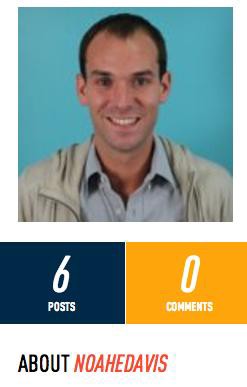
Slowly, it started to pay off. A story I wrote for The Awl prompted an editor at The Verge to contact me. I’ve written a number of features for them that paid between $750 and $1,500. After flying on Emirates Airlines and enjoying the in-flight magazine, I pitched the editor. He liked them and I continue to write features that pay a little less than a $1/word. I wrote slideshows for Complex.com for $10/slide (about sports, not hot women). I wrote a feature ($1,000) and blog posts ($250) for ESPN.com’s Grantland, and a photo-driven bit for ESPN The Magazine ($800).
I did pieces for BuzzFeed ($300), Penthouse ($750-$1,500), The Wall Street Journal’s sports section ($1/word), SBNation’s Longform unit ($1,750), Splitsider ($100), Guyism.com ($300/story), Street Fight ($0 but a slice of equity), The New Republic’s website ($150), and other outlets. Some paid more than they needed to, some paid less than they should. Deadspin gave me $100 for two pieces I wrote in Kiev, Ukraine. That seemed low, especially when they offered Jay Mariotti $1,000. (I’m 1/20th as valuable as he? Perhaps not untrue, but still, ouch.) At various points, I had contracts with mediabistro.com ($900/month), NBC ($350/month), Outside ($433/month), and Pacific Standard ($600/month).
I pitched and wrote constantly. I submitted invoices to between six and 12 outlets a month. But while I found consistent work, there were no massive payoffs. The most I made for a single piece was $2,200, although I did help launch and continue to edit American Soccer Now, a soccer website. I was paid a one-time fee of $10,000 and given a bit of equity. In my accounting, I spread that money over the six months starting in June, 2012 and now spend two hours a day working on the site, essentially for free.
I did less glamorous work, like ghostwriting a self-help guide ($40/hour) and some light editing and web production for a major media company ($50/hour). These weren’t my favorite assignments, but they paid well and freed me up to take a flyer on other pieces with low rates but potentially a bigger impact. Plus, while we’d all like to think there’s some magical fairytale land where freelancers write what they want when they want, that simply isn’t true. I have talked to many, many freelance writers while trying to figure out how to make it as one over the past eight years, and the vast majority take the occasional (or frequent) lucrative gig when it arrives.
I’m lucky. I’m making it work. I learned plenty about the economics of business, the good and the bad, especially that I am a poor negotiator. Still, I made a little more than $50,000 in the last six months of 2012 and around $45,000 during the first half of this year. It’s possible to succeed in this gig economy. It’s also exhausting. I’ve grown more ambitious and pitched bigger stories to larger outlets, but nothing has hit yet. Still, I keep trying.

Ken Doctor says that this “gig” model is actually a throwback to the past. “The journalism that developed post-World War II and lasted for so long was able to generate lots of middle-class jobs at middle-class wages. You would work for one employer and make enough money to live a middle-class life. Those jobs have mostly gone away, and the idea of doing two or three things at least for different people and cobbling together enough money to make a desent income is where a lot of this has gone,” the Newsonomics.com founder says. “That’s what a lot of journalists did pre-World War II. They worked two or three different jobs. They were contractors of one kind or another. Clearly, it’s going in that direction.” Tina Brown knows we’ve forgotten that history.

New entrants to the freelance world don’t expect to land huge contracts, which are even rarer today than they were in the past when media thrived. Instead, they fit the puzzle pieces together. After Ann Friedman was laid off from Good, she started writing weekly columns for CJR and NYMag.com, brilliant charts for The Hairpin, and other posts for various other outlets. “Reoccurring web columns are the backbone of my income,” she said.
Print isn’t the rule; it’s the exception, which Friedman learned (or perhaps already knew in her capacity as an editor). “My plan that I’m going to supplement my weekly web income with a few big print stories might not be feasible even two years down the road. I’m aware of that,” she said. “But for me, it’s a race against time. How can I build a personal brand as a journalist, not to Andrew Sullivan levels or anything, but the recognition that I have job security before the parachute of print assignments goes away? That’s how I see my personal calculus.”
“I’m personally very optimistic that I’m going to get there, but I think that there are other ways to do it, too. If the industry stabilizes at 30,000 jobs, which is something like half of the historical number, I plan to be one of those 30,000, because people will know me as a journalist already — not because I have a contract at a magazine.”
The plan is working. She called me while on a reporting trip for a major magazine, and AFAR recently sent her to Osaka, Japan to do a feature called “Spin the Globe” that caters to well-known writers.

The digital-first publications, even those with massive amounts of venture capital, have decent rationale for their pay rates. The print outfits, however…. “I actually think it would be possible for old-school print outlets to pay better if they wouldn’t over-assign or if they didn’t have super-fancy real estate in Midtown,” Friedman said. “The notion that media is both a struggling industry and a glamour profession is totally ridiculous. If you’re a struggling industry that’s worried about declining advertising revenues, fucking pack up, move to Brooklyn, and stop triple-assigning every issue.”

Condé Nast’s upcoming move to the World Trade Center was not actually a great deal; their base rent is something like $60 million a year, on average, escalating over time. That doesn’t count any costs like electricity or sales tax on rent, and their much-vaunted rent rebate of $46 million averages out at less than $3 million a year over 17 years. The World Trade Center hasn’t signed another commercial tenant since, in the last two years, which means offering rents are dropping. Media companies in general are terribly advised regarding real estate: while Time Inc. was being told by one consultant to take on an additional 300,000 square feet, in actuality, they already had 200,000 square feet they didn’t even need. (Time Inc.’s lease is up in 2017.)
Here’s a math problem: Condé Nast’s New Yorker, a publication with whom any freelance journalist would love to be associated, pays $250 for all online pieces. On one hand, that’s not much, particularly in contrast to their print rates. Yet it’s about what The New York Times pays for op-eds. And consider the economics: If NewYorker.com publishes eight pieces a day — not unreasonable at all — they pay out $2,000 a day. That’s half a million a year, just in freelance, and also not an insignificant amount of money.

There’s a vital distinction to be made between artistic value and monetary value. All writing (at least in theory) has the former, little of it has the latter, at least in any real magazine-world sense. “If my mom is going to blog, it doesn’t mean she should make a living off it,” Jackson said. “It seems like no one is saying that you can’t live on it because there’s too much supply and you’re not great at it. You’re not meant for it.”
Of course, there are benefits to this new world, like the opportunity to build something great. “Living in bombed-out Hamburg really sucks if you had a nice house, because you’re probably never going to see that house again,” Samuels said. “But it’s really not so bad if you’re 19-years-old and selling black market stockings in an alley somewhere. That wasn’t going to lead much of anything in pre-war Hamburg, but in the new post-war Hamburg you could end up as the Black Market Stocking King and before you know it, be the mayor of the city, because everybody else had their house leveled and is paralyzed by fear and loss. It’s a level playing field again. That’s exciting.”
“The problem now is,” he said, “who are you going to learn your craft from? What structures are going to support you in doing work that’s any good? And how are you going to know if it’s any good? Because what’s out there now is a bunch of shattered buildings and scared people — and that’s not a set of structures that allows for depth of knowledge and craft. Nobody looks at you now when you’re 27 and you write the kind of stuff that everyone who is 27 writes and says ‘hey, man, I know you think this is smart but there’s this, this, and that, and you need to have an aesthetic that governs what you do and isn’t dumb, and you need to actually spend time with the people you write about, and if you just join the herd of smart-asses on Twitter you will end up looking like a tool.’ That’s embarrassing, but you learn that way, or at least I did. Right now, those structures that I had, as limited as they were, don’t really exist at all. When all the older people are begging for spare change by the side of the highway, you don’t have a lot of incentive to listen to their wisdom.”

I’m not complaining. I make more money than my dumb-ass 21-year-old self ever thought I would when I decided to “move to New York and become a writer” my senior year of college. The lack of long-term stability can be troubling, especially on those frustrating days when editors aren’t returning my emails, but that’s a conscious trade-off I made for being able to go running in the middle of the day. I work hard, really hard, but not appreciably more or less so than my friends who are teachers, television producers, operations managers, and lawyers. Most of the time, I very much like what I do. This plan might not work forever, but in a world that’s less about traditional, one-company one-job careers and more about bouncing around and trying to find a way, it works for now.
When I was nearly done with this piece, I got curious and asked what I was getting paid. The answer is $250. Honestly, that seemed fair. Still, I think it’s worth more, and I would have done it for less.
Noah Davis (@noahedavis) should have been a rock star. Photo by “ishawalia.”
Pretty People Suck At Work Too
“A new research study finds people who are considered unattractive are more likely to be depreciated and intimidated in the workplace.”
A Poem By Jake Kennedy
by Mark Bibbins, Editor
Cezanne’s Still-Life with Skull, Candlestick, & Book
Poor Yorick would speak a speech
about fucking and how to run balls-out
into the sea; how the rose once moved
this way and that in the breeze
and how the pages were always turning towards
the better future (and they were)
yet there’s no light half as true
as the guttered candle; that’s the luminousness
around the shadow which is a fact
or something dope like that
with memory’s stagecraft
here stupefying all vanities —
Jake Kennedy lives in the Okanagan, BC. He and his BFF, poetcomicartfool kevin mcpherson eckhoff, are compiling a collaborative community western novel entitled Death Valley.
5 Apps That Help You Relax
by Awl Sponsors
“Some people are just highly sensitive, alright? The world is full of sirens, and horns, and screaming children and deadlines. Download these five apps on your Lenovo IdeaPad Yoga Ultrabook™ to shut out the chaos and relax.”
Danny Aiello Is 80
Daniel Louis Aiello, Jr. has had a long and distinguished career in the field of performing arts, but on this eightieth celebration of his birth let’s acknowledge perhaps his most memorable portrayal.
Thursday Is Holding Itself Back For The Weekend
Walk around outside today! Or other things.
This podcast is sponsored by Audible. From this link right here you may obtain a 30-day free trial of Audible and a free audiobook of your choosing! My word, that’s right, any book you want, for free.
Messin' Around With The F Word
“An article on June 6 about the Bushwick Open Studios event in Brooklyn misinterpreted a statement by the artist Juniper Alcorn in the process of paraphrasing it to eliminate an obscenity. Ms. Alcorn says that the vulgarity in her manifesto means that she is a feminist who messes around, not that she ‘sleeps around.’”
James Gandolfini, 1961-2013
There’s not a whole lot to be said about the passing of James Gandolfini that hasn’t been said already or won’t be over the next couple of days. Let’s just look at this clip from the final episode of “The Sopranos”; in a little under three minutes he hints at every aspect of what made his character so magnetic. You can’t imagine anyone else playing the role. He was 51.
A Portrait Of Boxing's First World Championship
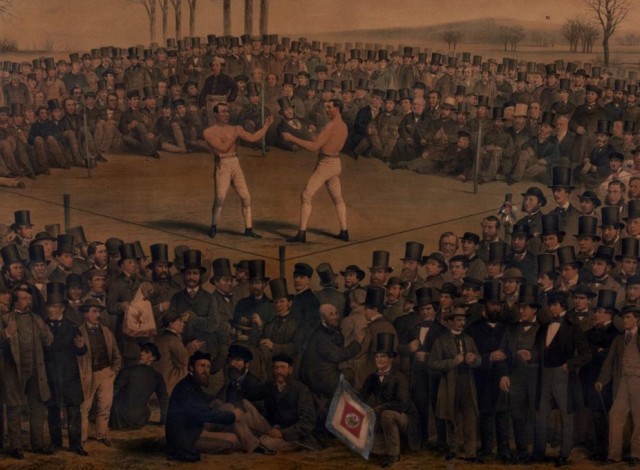
Hello, would you like to buy something weird? Hammer Time is our guide to things that are for sale at auction: fantastic, consequential and freakishly grotesque archival treasures that appear in public for just a brief moment, most likely never to be seen again.
“Stephen went down Bedford row, the handle of the ash clacking against his shoulderblade. In Clohissey’s window a faded 1860 print of Heenan boxing Sayers held his eye. Staring backers with square hats stood round the roped prizering. The heavyweights in tight loincloths proprosed gently each other his bulbous fists. And they are throbbing: heroes’ hearts.” — James Joyce, Ulysses, Episode 10, The Wandering Rocks
Tom Sayers’ right arm had been broken since the sixth round, but his bare-knuckled left fist still rendered John Camel Heenan’s face unrecognizable. During Round 29, Sayers’ only working fist finally managed to make contact with Heenan’s only working eye. But even with both eyes swollen shut, Heenan managed to end Round 37 with Sayers’ neck firmly placed between his hands and the rope. Exhausted, he leaned his 195-pound frame into his opponent, whose face turned purple under the pressure.
And that was before the rope was cut and the crowd rushed the ring. They still had five more rounds to go.
It had all begun months earlier. Bare-knuckle prize-fighting was illegal, but nearly every newspaper in the world had breathlessly speculated about the world’s first Heavyweight Championship. On April 17, 1860, thousands of men knew to show up at the London Bridge Station by 4 a.m. and purchase three-guinea tickets. The destination was marked “To Nowhere,” and the trains were simply called “Southbound Specials.”
Today in London, Bonhams auctioned off a color lithograph showing around 3,000 men — rumored to include Charles Dickens, William Thackeray, and the Prince of Wales — crowded behind the Ship Inn in Farnborough.
Organizers had strategically picked a spot along the Surrey-Hampshire border. If the police came, even the dukes, lords, earls, ministers, journalists, merchants and lawyers knew to run out of their jurisdiction. The butchers, barkeepers, fishmongers and day laborers knew, too, but hoped it wouldn’t come to that, and if it did, many intended to employ the weighted sticks and knives they had brought along.
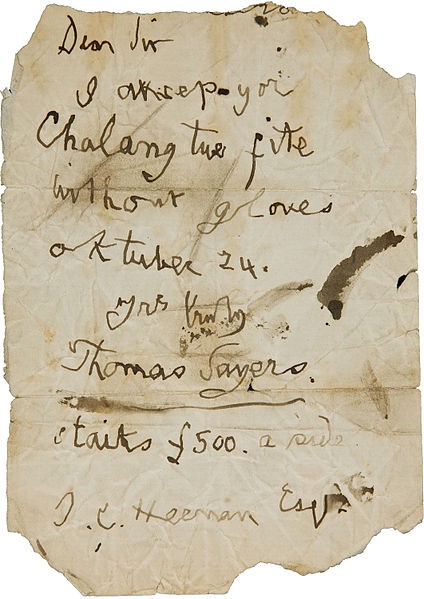
At half past seven, Sayers stripped down to his breeches. At just 5 feet 8 inches, the 33-year-old illiterate bricklayer known as “Brighton Titch” had won a series of titles, but his twenty-five-year-old American opponent had a good four inches and forty pounds on him. The English reporter Henry Mills observed the size difference, but concluded Sayers’ legs “were cast in a decidedly stronger mold than that of his opponent.”
Heenan had two nicknames back in San Francisco, where he often wielded a 32-pound sledge in foundries and fought for cash on the weekends. He maintained order in the dockyards sweatshops, where he was known as “Benecia Boy,” but around election time, local politicians simply called him “enforcer.”
“Time!” yelled the referee, and the boisterous crowd hushed, watching Heenan and Sayers bob and weave, holding and punching, aiming at first for the kidneys and other soft targets.
No regulation meant no rules. Rounds weren’t scored or demarcated by intervals; they ended when a man hit the floor.
Sayers drew blood first, but Heenan countered in the second round and by the fifth, odds were five-to-one on the American. During the twenty-minute long eighth round, men were climbing on each other’s shoulders and frantically placing bets, the heavy stakes quickly rising. Journalists’ accounts were somewhat influenced by national ties, but at this point, they all began to recoil at the “hideous and loathsome” injuries incurred by both boxers. At one point, Sayers’ knuckles caused such a great gash in Heenan’s right cheek that pink flesh hung limply off his face. When they retreated to their corners, their wounds were inadequately treated with a blood-soaked sponge.
“It’s an eye for an arm now,” Sayers reportedly said, but both boxers continued to spill copious amounts of blood on the grass for hours to come.
According to the London Times, a few policemen attempted to force their way into the ring, but the crowd “kept them back by rushing on the ropes, shouting and cheering the combatants to the utmost.”
By 9:30, the exhausted pugilists were flailing about, wildly throwing punches. More police arrived, batons in hand, and the focus shifted to the melee outside the ring.
And that’s when Heenan began to crush his opponent’s neck against the rope. The Times reported Sayers “would have been strangled on the spot had both umpires not called simultaneously to cut the ropes.” Still, the mob wanted the fight to continue, so they formed a protective circle around the fighters, leaving them just six feet on which to fight five more rounds.
The police finally gained entry two hours and twenty-seven minutes after the fight started, and the fighters fled. After 42 rounds, “Heenan was unrecognizable as a human being” and ran blindly into the field, while Sayers was seen “walking firmly and coolly away, with both his eyes open and clear.” Locals argued that Sayers had won, but in the end, both men were awarded silver championship belts and 400 British Pounds Sterling. They spent the next few months performing theatrical reenactments of their epic fight around England.
The backlash against the gruesome fight was substantial. The Saturday Evening Post wrote: “Compared with the bull-fighting of Spain and the cock fighting in Cuba, it is not only more barbarous, but dashed with a peculiarly Roglish trait of vulgarity.” By 1865, Parliament accepted the “Dozen Rules,” which included three-minute rounds and “no cross-buttock throwing whatever.”
Sayers never fought again. His supporters, including members of the House of Commons, raised £3,000 for his retirement, which he mostly spent on the drink. When he died at just 39, 30,000 people attended his Highgate funeral.
As for Heenan, he fought another world championship against Tom King, in 1863, but he lost in 24 rounds. By the time he died of a lung hemorrhage in Wyoming at the age of 38, he was destitute.
At Bonhams today, the lithograph of the first Heavyweight Championship, by W.L. Walton, went for £687, as part of the Sports Memorabilia and Golfing Heritage Auction. Who was the lucky buyer, we wanted to know. “No we do not release buyers confidential details by law,” was the full verbatim response from a Bonhams representative.
Alexis Coe is now a writer living in San Francisco, but not long ago, she was a research curator at the New York Public Library. Her work has appeared in the Atlantic, Slate, The Millions, The Hairpin, and other publications. Alexis holds an MA in history. Follow her. Image: detail from W.L. Walton’s lithograph.
